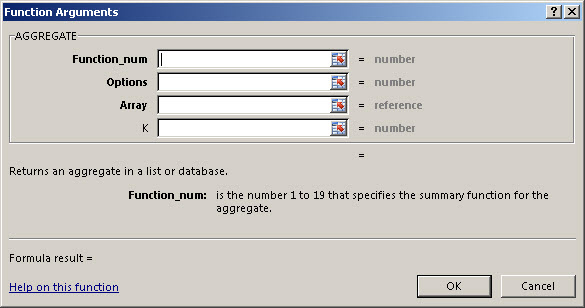AGGREGATE Function – Examples in Excel, VBA, Google Sheets
This Excel Tutorial demonstrates how to use the Excel AGGREGATE Function in Excel to perform calculates to a database, with formula examples.
AGGREGATE Function Description:
The AGGREGATE Function Calculates specified calculations (sum, average, etc.) for a database or a list.
Formula Examples:

| Example | Formula | Result |
|---|---|---|
| Average | =AGGREGATE(E5,F5,$B$5:$B$7) | 3.66666666666667 |
| Count | =AGGREGATE(E6,F6,$B$5:$B$7) | 3 |
| Sum | =AGGREGATE(E7,F7,$B$5:$B$7) | 11 |
| Percentile.Inc | =AGGREGATE(E8,F8,$B$5:$B$7,G8) | 2.8 |
Syntax and Arguments:
The Syntax for the AGGREGATE Formula is:
=AGGREGATE(function_num,options,array,k)Function Arguments ( Inputs ):
function_num –
options –
array –
k – 2 different options
Additional Notes
Use the AGGREGATE Function to perform defined calculations on a database or list.
AGGREGATE Examples in VBA
You can also use the AGGREGATE function in VBA. Type:
Application.Worksheetfunction.Aggregate(function_num,options,array,k)
For the function arguments (function_num, etc.), you can either enter them directly into the function, or define variables to use instead.
How to use the AGGREGATE Function in Excel:
To use the AND Excel Worksheet Function, type the following into a cell:
=AND(
After entering it in the cell, notice how the AND formula inputs appear below the cell:
![]()
You will need to enter these inputs into the function. The function inputs are covered in more detail in the next section. However, if you ever need more help with the function, after typing “=AGGREGATE(” into a cell, without leaving the cell, use the shortcut CTRL + A (A for Arguments) to open the “Insert Function Dialog Box” for detailed instructions:

For more information about the AGGREGATE Formula visit the
Microsoft Website.